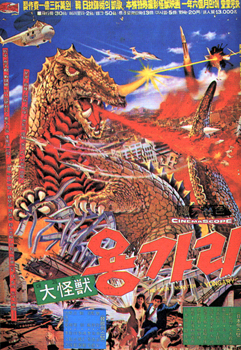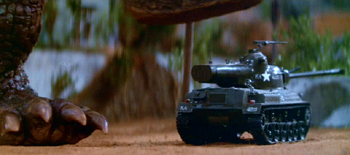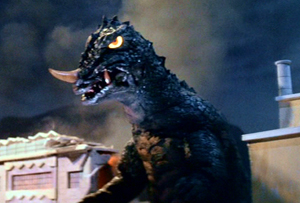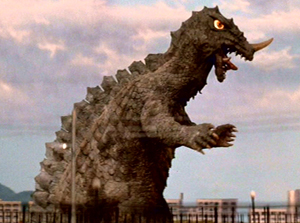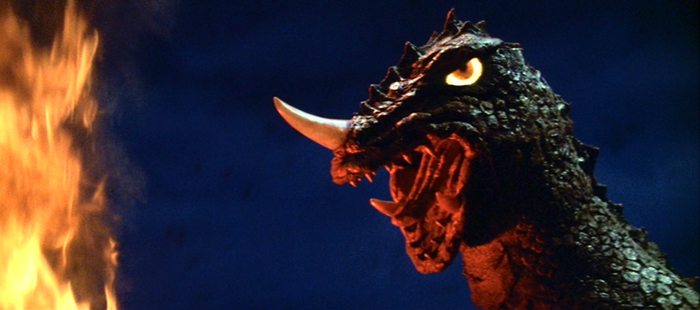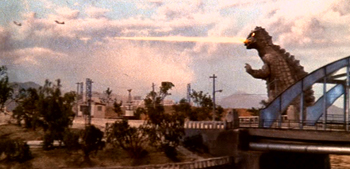 The giant monster Yongary advances on Seoul`s historical landmark the Great South Gate (Namdaemun) in YONGARY, MONSTER FROM THE DEEP, now on DVD from MGM. © 1967 Keukdong Entertainment Company
The giant monster Yongary advances on Seoul`s historical landmark the Great South Gate (Namdaemun) in YONGARY, MONSTER FROM THE DEEP, now on DVD from MGM. © 1967 Keukdong Entertainment CompanyA Look Back at Korea’s First Giant Monster Movie as It Finally Gets an Official Region 1 Release Author: Keith Aiken with Loomis (Kim Song-ho) Source: MGM Home Entertainment, Fox Home Entertainment, Talking about Korean Movies: The Korean Movie Renaissance 1, Korean Film Archive Special Thanks to James Owsley, Gary Teetzel, Shinichi Wakasa, and Callie Jernigan Contents:
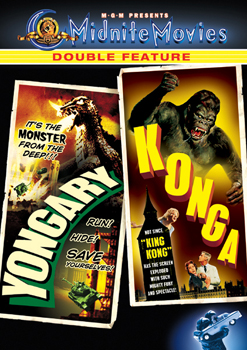 Cover art for the new YONGARY, MONSTER FROM THE DEEP /KONGA DVD. Photo courtesy of 20th Century Fox Home Entertainment. © 1967 Keukdong Ent. Co. /© 1961 MGM
Cover art for the new YONGARY, MONSTER FROM THE DEEP /KONGA DVD. Photo courtesy of 20th Century Fox Home Entertainment. © 1967 Keukdong Ent. Co. /© 1961 MGMFor several decades, Japan has been the chief producer of giant monster movies in Asia. But with Godzilla and Gamera currently in retirement, South Korean film studios have taken up the slack and so far been tremendously successful with their own creations. Last year’s THE HOST (Gwoemul) became the highest-grossing domestic release in Korean history and was named Best Picture at the Korean Film Awards, sold in more than 30 countries, and praised by fans and reviewers worldwide. DRAGON WARS: D-WAR (2007) is currently tearing up the box office in Korea, and on September 14 opened on 2,275 screens in the United States to become the first Korean film ever to have a wide theatrical release in America. By coincidence, the same week that DRAGON WARS began its US run, South Korea’s first giant monster movie received a long-overdue official Region 1 DVD release. YONGARY, MONSTER FROM THE DEEP (1967)— described as “the quintessential giant monster movie of Korea” — is now available as a “MGM Midnite Movies” double-feature disc with the British giant ape picture KONGA (1961). Known in its homeland as THE GREAT MONSTER YONGGARY (Daeguesu Yonggary), the film was produced by the Keukdong Entertainment Company (Keukdong Heungup, meaning "Far East Entertainment Co."). The 1960s were the heyday of Korean cinema, with Keukdong one of the many studios responsible for a number of critically and commercially successful films that are still fondly remembered today. The company was co-founded by Cha Tae-jin — producer of nearly a hundred movies during the 1960s and 70s— and director Kim Ki-duk. Kim was one of the most prominent directors of that era, and some of his pictures such as THE FIVE MARINES (O In-Ui Haebyeong, 1961) and THE BAREFOOT YOUNG (Maenbal-Ui Cheongchun, 1964) are considered classics.
In late 1966, Keukdong Ent. was looking for new genres to explore. At that time, Japan was in the midst of a “giant monster boom”… each of the five major Japanese studios (Toho, Daiei, Shochiku, Toei, and Nikkatsu) produced at least one monster movie, and monster-themed TV programs like ULTRAMAN and THE SPACE GIANTS were routinely bringing in high ratings. In addition, the Japanese productions were consistently sold to distributors in the United States. Keukdong took note of this success and decided that they would make the Korean equivalent of a Japanese monster movie. As with Godzilla and many of the Japanese monsters, the look and name for the new Korean beast were not chosen at random but actually reflected on its nature and origins. In an interview for the Korean Film Archive, director Kim Ki-duk explained that two words were the basis of the name `Yonggary`. One of those inspirations was `Pulgasari`, a monster from Korean legends that was featured in an obscure 1962 movie and an infamous North Korean film made in 1985. The director also chose the word `yong`, meaning `dragon`... largely considered as a symbol of might in the East. Yong is a Korean pronounciation of the Chinese letter ? that is also used in Japan to mean `dragon` (the Japanese pronounciation is `ryu`). The Korean word `gongryong` means `dinosaur`, with the suffix `ryong` derived from `yong.` It also shared the same Chinese letter as `kyoryu,` a Japanese word for `dinosaur`. Kim and the producers brainstormed many ideas of what the monster would look like, and eventually decided on a dinosaurian appearance that went well with the name `Yonggary` . The studio’s first major hurdle was in learning how to make a giant monster movie; a difficult task since there had been no such films ever made before in Korea. The producers invited Japanese fx technicians to work on THE GREAT MONSTER YONGGARY, and eventually partnered with Toei Co., Ltd. Kim Ki-duk stated that associate producer Lee Byoung-woo, a Korean cinematographer who was also a naturalized citizen of Japan, acted as an intermediary between the Korean producers and the Japanese crew. Lee, whose Japanese name was Kan Inoue, directly participated in the making of the film and helped train the Korean staff in the special effects techniques used by the Japanese crew. Kim recalled that the Korean special effects and art direction teams were spurred on by the opportunity to improve their craft and create an audience-pleasing motion picture.
Among the Japanese personnel were Masao Yagi, who built the Yonggary suit, and mechanical engineer Akira Suzuki, who had created mechanical props and devices for many of Toho’s films. A little over a year before, the pair had partnered with Toho monster maker Keizo Murase to form the special effects house EX Production. The company created the Gamera costume for the original GAMERA (Daikaiju Gamera, US title GAMMERA THE INVINCIBLE, 1965) and went on to work on many of Toei’s Masked Rider shows and programs like SECRET TASK FORCE GORANGER (Himitsu Sentai Gorenja, 1975). Many of Yonggary`s features such as the tusks and light up eyes call to mind the monster costumes made for Daiei`s Gamera films. The screenplay for THE GREAT MONSTER YONGGARY was written by Seo Yoon-seong. Production design was by Roh In-taek, a regular contributor to Kim Ki-duk’s films. The music was created by Jeon Jeong-keun, an incredibly prolific composer with 441 film scores to his credit. The directors of photography were Byeon In-jib and Lee Seong-chun. The film was shot in scope and had a running time of 80 minutes (rumors of a 100 minute version turned out to be incorrect).
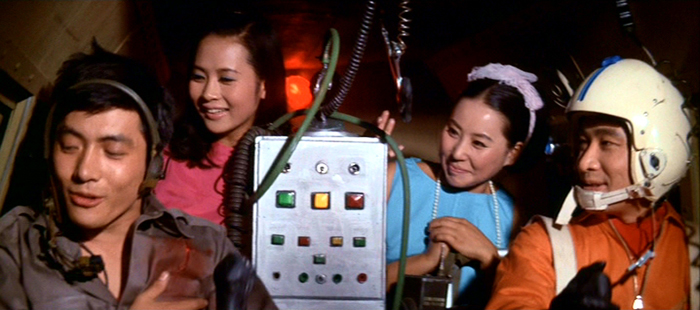 The main characters of THE GREAT MONSTER YONGGARY— Ko Il-woo (Oh Young-il), Yoo Soon-a (Nam Jeong-im), Kim Yu-ri (Kang Moon), and her husband Yoo Kwang-nam (Lee Soon-jae)— happily attempt to kill the monster. © 1967 Keukdong Entertainment Company
The main characters of THE GREAT MONSTER YONGGARY— Ko Il-woo (Oh Young-il), Yoo Soon-a (Nam Jeong-im), Kim Yu-ri (Kang Moon), and her husband Yoo Kwang-nam (Lee Soon-jae)— happily attempt to kill the monster. © 1967 Keukdong Entertainment CompanyThe cast consisted mainly of young stars such as Oh Young-il, Kim Dong-won, Kang Moon, and Twist Kim who were regulars of 1960s Korean cinema. Nam Jeong-im, who played Soon-a, the unhappy girlfriend of young scientist Ko Il-woo (top billed Oh Young-il, his character was named `Illoo Nami` in the English dubbed version from AIP-TV), was a massively popular actress during the mid-1960s and the early 1970s. She passed away in 1992. Twist Kim had a small part as a soldier whose jeep is cut in half by an energy beam from Yonggary`s horn. Before fleeing from the rampaging monster, he knelt for a moment and rubbed his hands— a Korean gesture done to beg for life, forgiveness, or mercy. Kim Shin-jae was the mother of the newlywed bride Kim Yu-ri (called On-na in the English dub). The eight year old boy Yoo Young (also known as `In-cheol`, the character was called `Icho` in the English dub) was played by child actor Lee Kwang-ho, and suit actor Cho Kyoung-min performed the role of Yonggary.
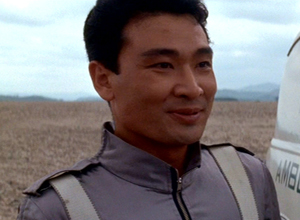 40 years after YONGARY, actor Lee Soon-jae is still active in film and television. © 1967 Keukdong Entertainment Co.
40 years after YONGARY, actor Lee Soon-jae is still active in film and television. © 1967 Keukdong Entertainment Co.While most of the cast have long since retired, there is one notable exception in Lee Soon-jae, the actor who played Rocket Control Center astronaut Yoo Kwang-nam. Now in his 70s, Lee is still vigorously active in the industry and is highly respected by his fellow actors and fans. He recently starred in the hugely popular television sitcom UNSTOPPABLE HIGH KICK (Geochimeopsi High Kick, 2006) and found a new legion of fans, particularly amongst youngsters. THE GREAT MONSTER YONGGARY was a massive production by Korean standards of the time. The budget was 13 million won (approximately $50,980 US at 1967 exchange rates), roughly 3 to 4 times the cost of the average Korean film. The movie opened at the Kukje Cinema on August 13, 1967 and eventually had 150,000 admissions (statistics in Korea are unclear if that number describes tickets sold in Seoul or nationwide). The film`s impact in Korea is still being felt to this day. In a recent interview for Fangoria, director Hyung-Rae Shim said, “There was a movie that came out in 1967 called YONGGARY which I enjoyed very much. The effects are of course very dated now, but at the time I was very inspired by it.” In 1999 he released his own version of YONGGARY, followed two years later by a revised version called YONGGARY: 2001 UPGRADE EDITION. The "reimagining" was a critical and commercial flop, and was quietly released on American DVD by Sony Pictures in 2001 with the new title REPTILIAN. Shim dusted himself off and immediately jumped back into the giant monster genre with the much more successful DRAGON WARS.
Just as the Keukdong Entertainment Company had hoped, THE GREAT MONSTER YONGGARY was quickly sold to a US distributor. American International Pictures picked up rights to the film and released it through their television division in 1969 as YONGARY, MONSTER FROM THE DEEP. AIP-TV turned to post-production supervisor Salvatore Billitteri to handle the Americanization of YONGARY. Billitteri had supervised the English language versions for many Japanese films, including ALAKAZAM THE GREAT (Saiyuki, 1960), FRANKENSTEIN CONQUERS THE WORLD (Furankenshutain tai Chite Kaiju Baragon, 1965), DESTROY ALL MONSTERS (Kaiju Soshingeki, 1968), DESTROY ALL PLANETS (Gamera tai Uchu Kaiju Bairasu, 1968), YOG: MONSTER FROM SPACE (Gezora, Ganime, Kameba: Kessen! Nankai no Daikaiju, 1970), and GODZILLA VS THE SMOG MONSTER (Gojira tai Hedora, 1971). The English dub was done by Titra Sound Corp., AIP’s chief dubbing facility. Oddly, the American version of YONGARY does not provide names for many of the main characters, and the names that are used are a strange mishmash of Korean and Japanese. YONGARY, MONSTER FROM THE DEEP was regularly shown in television syndication throughout the 1970s until FCC deregulation brought an end to most independent UHF stations in the early 1980s. Over the next few decades, US ownership of the film repeatedly changed hands. AIP was bought by Filmways, Inc. in 1979, and three years later Filmways merged with the Orion Picture Corporation. In November 1989, Orion Home Video released YONGARY on video for the first time, both on VHS and as a pan & scan laserdisc double-feature with the Shochiku giant monster movie THE X FROM OUTER SPACE (Uchu Daikaiju Girara, 1967).
Following Orion’s bankruptcy in 1992, the company was acquired by Metro-Goldwyn-Mayer Studios in 1997. In 2003, MGM reissued YONGARY to cable television (where it is occasionally shown on the Starz/Encore channels and Monsters HD) and now finally on DVD. MGM Home Entertainment`s DVDs are currently distributed by 20th Century Fox Home Entertainment, which brings YONGARY’s rather convoluted history in America to its current point. Even more baffling than YONGARY, MONSTER FROM THE DEEP`s travels in the United States is the fact that no original negatives of THE GREAT MONSTER YONGGARY survived in South Korea. According to director Kim Ki-duk, at the time the film was made very few Korean movies were exported, so when YONGGARY was sold overseas the producers shipped all the original materials abroad, including the negatives. While such actions are almost unbelievable from today`s point of view, they were simply the results of Keukdong Entertainment Company`s inexperience four decades ago. The Korean Film Archive has only a section of a release print, running 48 minutes. Reportedly, even this part is not in playable condition because of perforation damage. Therefore, despite its historical value as the first giant monster film in Korea, THE GREAT MONSTER YONGGARY has never been officially released on home video in the country where it was made. Fortunately, the elements for the AIP version of YONGARY were preserved, and the film looks absolutely stunning on the new MGM DVD. While the release is "bare bones" in terms of extras (the only features are English audio in mono and stereo, mono French and Spanish tracks, and English and Spanish subtitles), the movie itself is presented for the first time in the correct 2.35:1 theatrical aspect ratio... a far cry from earlier unauthorized DVDs sourced from worn 16mm TV prints. The B side of this flipper disc features KONGA, in 1.85:1 widescreen and apparently ported over from the earlier MGM/Sony DVD (the previews are all for Sony titles, including GODZILLA: FINAL WARS). For finally giving viewers a chance to see YONGARY, MONSTER FROM THE DEEP in widescreen, MGM`s Midnite Movies DVD is a steal at the SRP of $14.98. _________________________________________________________________________________________________________
BRINGING YONGARY TO DVD: INTERVIEW WITH JAMES OWSLEY
The new Midnite Movies YONGARY, MONSTER FROM THE DEEP DVD was supervised by James Owsley, the former Director of Technical Services for MGM. James began his career as a freelancer working in music videos and commercials, as well as researching materials such as deleted scenes and alternate takes for movie laserdiscs. He worked at MGM for eight years, preparing films for both television and DVD. Since the studio had acquired so many movie libraries they had a tremendous selection of older titles, and much of James’ job involved going through the archives in search of the original materials, and painstakingly restoring the film and audio. James currently works at Sony Pictures as a Technical Services Specialist of Asset Management. He alternates between preserving and prepping older films in the Columbia Pictures library and getting newer titles ready for Blu-Ray release. He kindly agreed to discuss his work on YONGARY as well as some current projects…
SciFi Japan: Have you done a lot of the Midnite Movies line, or was YONGARY a specific case? James Owsley: The Midnite Movies were something that was set up by MGM Home Entertainment. When we acquired the Orion library [which included American International Pictures] it did need a lot of work because all of the masters were done a while back and there was a lot of restoration work that needed to be done. I got a lot of the more challenging ones, let’s say, and it turned out that a lot of the ones I worked on have come out in the Midnite Movies. Some of the ones I worked on were CRY OF THE BANSHEE, MURDERS IN THE RUE MORGUE, WILD IN THE STREETS, GAS-S-S-S, and SQUIRM. And a lot of those films, I personally liked them and they were kind of a kick to work on because sometimes I had to piece them together a little bit and make sure I had the right version. So at that time it wasn’t necessarily market driven, but as we acquired this library obviously the sales department is going to be going, “Oh, new films to sell!” and we had to get these films ready. Being that these films hadn’t had anything done to them in years, it was really nice to go in and check out what kind of condition these films were in and what we could do to bring them back a little bit. There’s just a lot of films that have a loyal following; if you read anywhere there’s always people going “When is this film coming out?” I tried at MGM and I’m trying now at Sony to get the most correct version as possible and really try to get what the director wanted in the film.
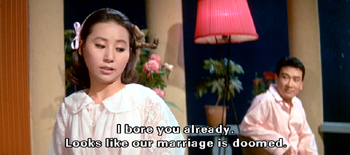 Astronaut Yoo Kwang-nam`s wedding night gets off to a very rocky start. Subtitles from the new MGM DVD. © 1967 Keukdong Entertainment Company
Astronaut Yoo Kwang-nam`s wedding night gets off to a very rocky start. Subtitles from the new MGM DVD. © 1967 Keukdong Entertainment CompanyOne of the big projects I worked on at MGM was the Bond restoration, in which I did a lot of work on all the Bond films that came out in those boxed sets. I’m working right now on the Three Stooges, and we’re doing restoration on all of those which is a lot of shorts. SFJ: I’m a Three Stooges fan, so before we get back to YONGARY I have to ask if these new DVDs will be in chronological order. JO: They are going to be done in order. We’ve made new film elements, new transfers… we’ve done a lot of work in cleaning them up… definitely doing all the research that these are the definitive versions of each of these. That in itself takes a bit of work, because when they were re-released in the 1950s and 60s for the television market they would often edit them, taking out the more risqué jokes. So we want to make sure that we’re putting out the full versions with nothing edited, nothing cut. And it will be every one, all the way to Joe Besser. And hopefully even include some of their solo shorts… some solo Shemp Howard, some solo Joe DeRita, and some solo Joe Besser. Plus, the Stooges were also in various lesser known Columbia films like musical revues and we’re working in all of that. News reels… we’re trying to restore everything Stooge. SFJ: The big thing with YONGARY is that the film is finally available in widescreen. Back in 1969, American International Pictures sent the movie straight to television so it was always shown pan & scan in the US. How were you able to finally present it in the correct aspect ratio?
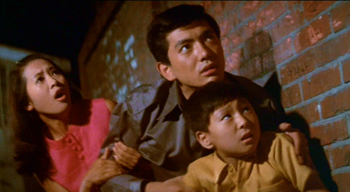 Soon-a (Nam Jeong-im), Il-woo (Oh Young-il), and Young (Lee Kwang-ho) witness the destructive power of Yongary. © 1967 Keukdong Entertainment Company
Soon-a (Nam Jeong-im), Il-woo (Oh Young-il), and Young (Lee Kwang-ho) witness the destructive power of Yongary. © 1967 Keukdong Entertainment CompanyJO: American International bought that film specifically for television. In those days, what they would do — because it was before video — is make a 16mm print. That would be what was shown on TV. Films of that time were pretty much widescreen, whether they were scope or 1.85:1 so they would do what is called a 16mm reduction and actually do the pan and scanning when they were doing the reduction. It was really tough, and a lot of times you would get shots where there are things like two noses talking. With AIP, they would sometimes pick up the rights to films and make a Color Reversal Internegative from the original negative [an inexpensive way to make a printing negative without having to go to an interpositive], cut that, and never touch the original negative. Sometimes I would go back to a film like MURDERS IN THE RUE MORGUE and there’s the original English version, untouched and in great condition. Other times, unfortunately, they would cut the original negative and that would be a much tougher situation. On VAMPIRE LOVERS I was able to find that Hammer Films still had some of the parts that had been cut out of the original negative that American International did and we were able to put things together from color separations. As I went through the inventory on what AIP had on YONGARY it was kind of limited beyond a lot of 16mm elements that they made. Because there was no theatrical release they did not have the original negative. They did have one 35mm interpositive, which is a positive picture element that’s made from the original negative. And that one was an anamorphic scope film. So we were very fortunate to have a picture element that was widescreen. It didn’t have any main or end titles; it just was the picture itself. The titles and all the credits never existed on the 35mm element.
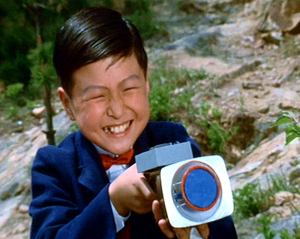 The mischievous Yoo Young (Lee Kwang-ho) is constantly causing trouble for people and monsters. © 1967 Keukdong Entertainment Company
The mischievous Yoo Young (Lee Kwang-ho) is constantly causing trouble for people and monsters. © 1967 Keukdong Entertainment CompanySFJ: Finding the IP for YONGARY must have been a surprise. JO: Sometimes you find a welcome surprise and sometimes you have to keep looking. You have to check with the filmmakers if you’re lucky enough that they’re still around. We went back and did a lot of research in trying to find more original elements because it would have been nice to put out this film in Korean as it was originally made. It would have been nice to find all the original titles and everything like that, but after doing a lot of research and going back and forth… we were told by the Korean production company that the original material for the film had been ‘terminated’. I don’t know exactly what that means, but it kind of put us at a dead end. SFJ: So the studio [Keukdong Entertainment Company] that made YONGARY is still in business? JO: We were in touch with whoever had taken over for the original production company, and it may well be that they did not know for sure what elements they had. We tried as much as we could to find the Korean YONGARY. And again, sometimes there are problems because of the language barrier, but we were told that it was terminated. That how they said it… terminated, y’know? It is kind of surprising when that happens, but sometimes a production company is really small and they just can’t afford the storage, or the company is sold and things get lost. These things happen, unfortunately. I’ve since heard that there are some materials in the Korean Film Archives, but it doesn’t even sound like a complete original negative [see the main article above for more info]. And that was long after we had worked on the film, and you sometimes have to play the hand that’s been dealt you.
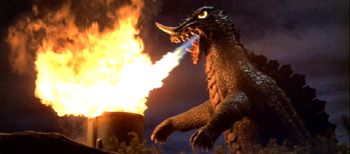 Following in Gamera`s footsteps, Yongary gains energy by feasting on fire. © 1967 Keukdong Entertainment Company
Following in Gamera`s footsteps, Yongary gains energy by feasting on fire. © 1967 Keukdong Entertainment CompanyKnowing that, we may have some of the few full picture elements in existence and that was kind of exciting. A little frustrating too, because the IP had some problems; things that film elements of that time would normally have because they’re a little bit older. The good thing was it hadn’t been used much, and because of that it was in great condition. So we were able to go ahead and use the dub track that was made by AIP so it’s in English. And we viewed 16mm prints that they had done and reconstructed the main and end titles, following the font and look of the original AIP version. We actually did find the outer space footage from the opening of the movie; we found a scope version of that in some trim boxes. So rather than blow up the 16mm elements — which were pretty beaten up, too — we were able to find the textless backgrounds for the main and end titles and in video write in all the English titles. Since we didn’t have a guide on how to do it from the Korean release we tried to follow the original AIP release from TV. I wish that I had a better “Indiana Jones” type story with YONGARY but I don’t. Unfortunately it’s not one of the ones where you say, “Ah ha! I found the Korean version!” but we were able to put together the scope version. On the DVD you’ll be able to see something that no one has ever seen.
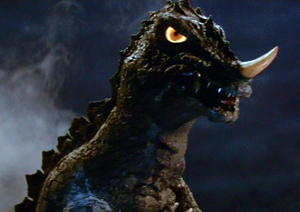 While attacking a factory, Yongary is annoyed by residue from a chemical explosion. © 1967 Keukdong Entertainment Company
While attacking a factory, Yongary is annoyed by residue from a chemical explosion. © 1967 Keukdong Entertainment CompanyWhen a film was shot in scope and you finally see it in scope it’s almost shocking. You can see that the movie was set up and lit as a scope film. There’s set design and placement… to actually see it in widescreen is startling. SFJ: Having the film in widescreen alone makes this DVD worth picking up. And, like you said, by all accounts the Korean version is lost and hasn’t been shown in Korea for decades. It sounds like you did everything you could at this point. JO: Personally, I always try to go at the end of the day, “Well, we tried as much as we can,” because I really do feel that every film is important to somebody. There was a lot of time and effort put into making YONGARY and it means something to— not just one person, but a group of people. No matter how obscure or unknown a film is, it’s worth going to the mat for because it’s not easy to make a film. There’s a lot of costs and all… I mean, I’m sure a lot of people can look at parts of it and laugh a bit — and obviously the dance that Yongary did is for fun and all — but it does have a certain style to it that is a little bit different from the monster movies of the time. I think it’s a fun film. When we did the transfer we did do it in high def, and we did digitally clean it up. We also did some sound restoration… we “no noised” the sound elements and made sure that it was nice and clear. The presentation is pretty good on this one. SFJ: So how long did you work on YONGARY?
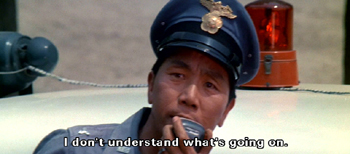 No need to fear: the authorities are in control of the situation and all is safe. © 1967 Keukdong Entertainment Company
No need to fear: the authorities are in control of the situation and all is safe. © 1967 Keukdong Entertainment CompanyJO: With YONGARY, it took me a little longer on this film because I did not want to do anything until I really exhausted every possibility. I really wanted to make sure that we 100% could not find something. The film was one that I was working on for probably about four years just because it was a lot of phone calls, a lot of trying to follow up on leads, and taking time opening up every box I could find. And I reached a point where I said, “That’s what I got to work with”. SFJ: Four years… JO: That one had a lot of research, and it wasn’t the only thing I was working on. It was pretty much calling, waiting for a response, calling, waiting for a response, following a dead end here, there, and everywhere. I could have started as soon as I looked at the elements I had but I really wanted to make sure I had the correct elements… or in this case, the only elements to work with. It took about four years, but not four consecutive years if you know what I mean. There were starts and stops, and at any time I was working on 30 to 50 films. But YONGARY was always on my plate and I did not want to proceed until I was as certain as I could be that I had everything.
SFJ: Was there anything in the way of advertising materials for YONGARY? I’ve seen television promos for some of the AIP-TV titles… was there anything like that for YONGARY? JO: They did have a trailer for YONGARY, but it was very much unfinished. I never found any sound elements for it, but I don’t know if anything was done after I left MGM [there is no trailer on the DVD]. Trailers are somewhat — not less important — but for older films you may find a trailer, and it will be missing narration or text, and that may be all that they’ve got. They were several elements, and this was the only material they could find. I don’t know about any other kinds of publicity because that would not be in my area. SFJ: Thank you for taking the time to talk about the work that went into the YONGARY DVD. The Japanese monster movies have been covered extensively in the US, but very little is known about this film or the people who made it because it’s Korean.
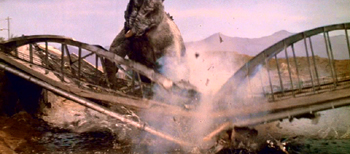 Wounded by a chemical assault, Yongary still finds the strength to destroy a bridge. © 1967 Keukdong Entertainment Company
Wounded by a chemical assault, Yongary still finds the strength to destroy a bridge. © 1967 Keukdong Entertainment CompanyJO: It’s a little different situation. Toho Studios is pretty strong about keep the elements for a lot of their stuff so its is a little easier trying to restore those films than something like this. YONGGARY was a Japanese/Korean co-production. As vibrant as the Korean film industry is now, back in 1967 it wasn`t nearly as big. SFJ: It’s really started booming in the last few years. JO: Oh yeah, it’s amazing. And they’ve got some terrific films… I loved THE HOST. I thought that was really great. OLDBOY… they’ve got some great stuff coming out now. I have to say THE HOST is probably one of my favorite monsters from the last few years; it was fantastically designed. It was terrific. I was in Hong Kong last year and caught it in a theater there. I didn’t even think it would get released here because it’s got that anti-American thing going through it. It’s fun to have something that’s kind of scary, kind of funny, and kind of touching all at the same time. You see that in a lot of Chinese and Korean and some Japanese films; those kinds of tone shifts. I find it refreshing because it keeps you off guard. As for YONGARY, I’m not at MGM anymore but I’m seeing some of my “children” from those days come to light and it’s neat to see that. I like to peek in and see what the reviews are like. Literally, this Tuesday [September 11], three films I did a lot of work on came out. One is YONGARY, one is FROM BEYOND, and the other is WITCHFINDER GENERAL. It was good to see all three come out, and they’re getting pretty good reviews and feedback. It’s kind of nice to see that.


